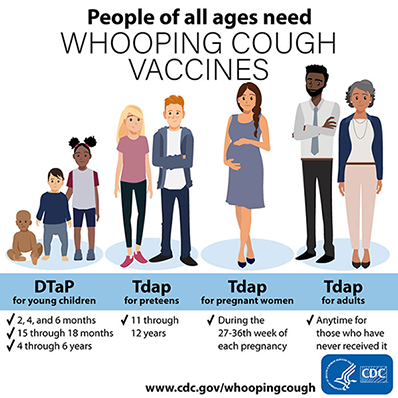
Pertussis (Whooping Cough)
Pertussis, also called “whooping cough,” is a disease caused by respiratory bacteria. It begins like a cold, with a runny nose, sneezing, mild fever and cough that slowly gets worse into strong “coughing fits.” This type of coughing may last for six or more weeks. To help prevent pertussis, there is a routine vaccination schedule for babies and children, and the vaccine is also available for all ages.
Transmission
Whooping cough spreads when:
- an infected person coughs or sneezes
- a person breathes in small particles that has the bacteria in it
- an infected person shares the same breathing space, such as holding a newborn on your chest
Symptoms
People infected with whooping cough usually show symptoms within five to 10 days after coming into contact with the bacteria. It is possible that symptoms do not develop for as long as three weeks. Symptoms of whooping cough has three stages:
Stage 1: Early Symptoms
Early symptoms can last for one to two weeks and can include:
- Runny or stuffy nose
- Low-grade fever (less than 100.4 degrees F)
- Mild, occasional cough (babies do not have this symptom)
- Life-threatening pauses in breathing (apnea)
- Turning blue or purple in babies and young children (cyanosis)
Stage 2: Later Symptoms
Later symptoms can happen one to two weeks after the first symptoms appear and lasts up to six to 10 weeks. In this stage, the main symptom is coughing fits. Coughing fits can cause people to:
- Make a high-pitched "whoop" sound when they take a breath in after the end of a coughing fit
- Vomit during or after coughing fits (paroxysms)
- Feel very tired after a fit, but feels fine in-between coughing fits
- Struggle to breathe
Many babies with whooping cough do not have these symptoms, but instead they may turn blue or struggle to breathe. For babies, symptoms may seem like a common cold.
Stage 3: Recovery
Recover lasts about two to three weeks. During this stage, the coughing begins to lessen but fits can still occur. For many months after infection, it may be easier to catch other respiratory infections.
Care
The best way to prevent whooping cough is to get vaccinated. There are two types of vaccines available: DTaP and Tdap.
Take steps to relieve symptoms
- There are antibiotics that treat whooping cough. Please talk to your doctor as early as possible.
- Use a clean, cool mist humidifier to help loosen mucus and soothe the coughing.
- Wash hands often with soap and water for at least 20 seconds
- Drink lots of fluids including water, juices, soups, and fruits to prevent dehydration. if you feel dehydrated, please tell your doctor as soon as possible.
- Do not take cough medicine unless your doctor recommends them.
If these tips do not work and symptoms are worsening, especially in babies, contact your healthcare provider and seek immediate care.



 TARRANT COUNTY, TX
TARRANT COUNTY, TX

 Epidemiology
Epidemiology